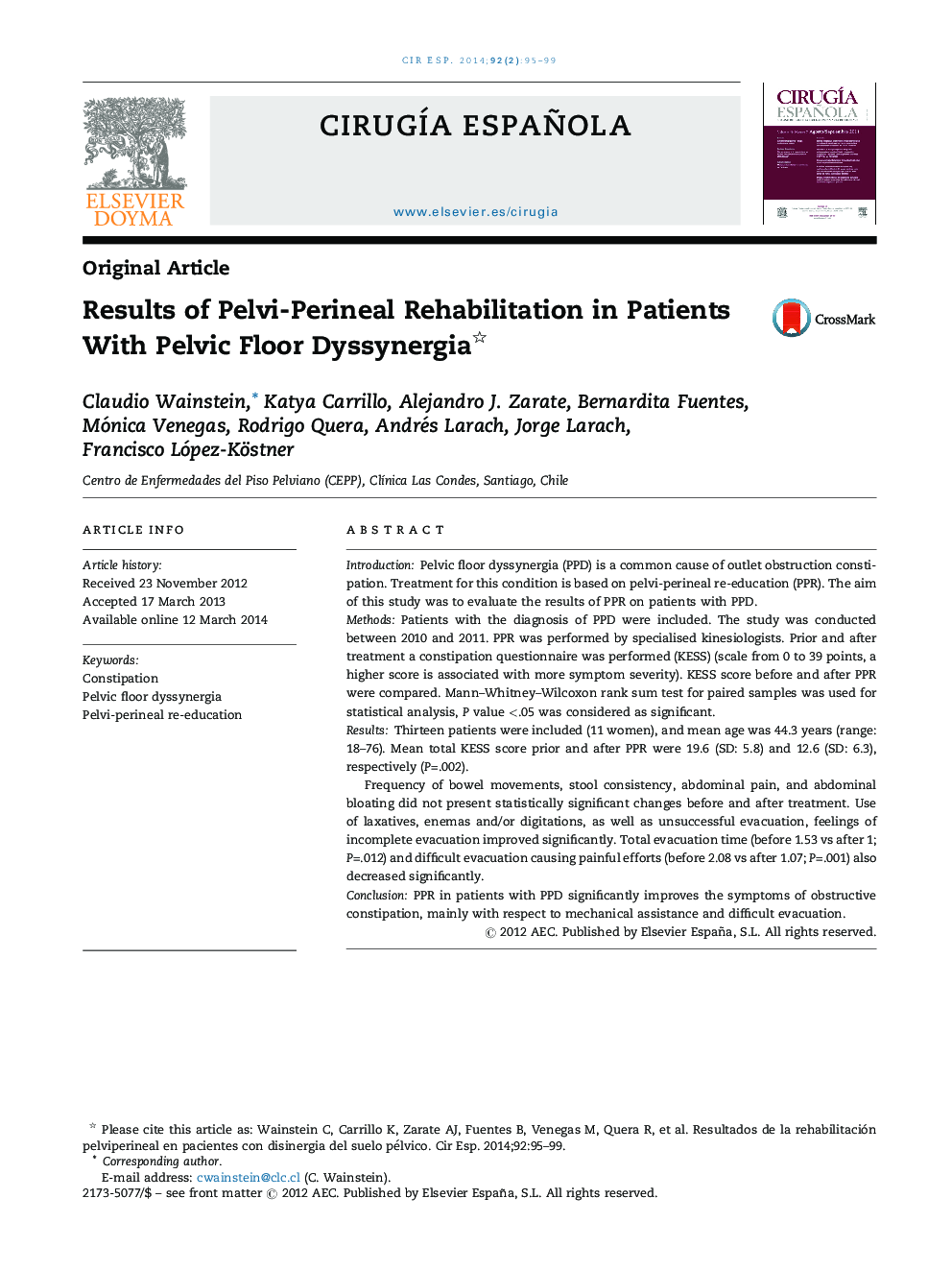| کد مقاله | کد نشریه | سال انتشار | مقاله انگلیسی | نسخه تمام متن |
|---|---|---|---|---|
| 4254746 | 1284401 | 2014 | 5 صفحه PDF | دانلود رایگان |
IntroductionPelvic floor dyssynergia (PPD) is a common cause of outlet obstruction constipation. Treatment for this condition is based on pelvi-perineal re-education (PPR). The aim of this study was to evaluate the results of PPR on patients with PPD.MethodsPatients with the diagnosis of PPD were included. The study was conducted between 2010 and 2011. PPR was performed by specialised kinesiologists. Prior and after treatment a constipation questionnaire was performed (KESS) (scale from 0 to 39 points, a higher score is associated with more symptom severity). KESS score before and after PPR were compared. Mann–Whitney–Wilcoxon rank sum test for paired samples was used for statistical analysis, P value <.05 was considered as significant.ResultsThirteen patients were included (11 women), and mean age was 44.3 years (range: 18–76). Mean total KESS score prior and after PPR were 19.6 (SD: 5.8) and 12.6 (SD: 6.3), respectively (P=.002).Frequency of bowel movements, stool consistency, abdominal pain, and abdominal bloating did not present statistically significant changes before and after treatment. Use of laxatives, enemas and/or digitations, as well as unsuccessful evacuation, feelings of incomplete evacuation improved significantly. Total evacuation time (before 1.53 vs after 1; P=.012) and difficult evacuation causing painful efforts (before 2.08 vs after 1.07; P=.001) also decreased significantly.ConclusionPPR in patients with PPD significantly improves the symptoms of obstructive constipation, mainly with respect to mechanical assistance and difficult evacuation.
ResumenIntroducciónLa disinergia del piso pelviano (DPP) es una causa frecuente de estreñimiento por obstrucción defecatoria. El tratamiento de esta enfermedad esta basado en la rehabilitación pelviperineal (RPP). El objetivo de este estudio es evaluar los resultados de la RPP en pacientes con DPP.MétodosSe incluye a pacientes con DPP a quienes se les realizó RPP entre el año 2010 y el 2011. Se aplicó previamente a las sesiones y al término de ellas un cuestionario de estreñimiento (KESS) (escala de 0 a 39 puntos: a mayor puntuación mayor sintomatología). Se compararon los resultados del cuestionario KESS, de forma previa y posterior a la RPP. Análisis estadístico mediante Mann-Whitney-Wilcoxon para muestras pareadas; se consideró significativo p < 0,05.ResultadosSe incluyó a 13 pacientes (11 mujeres), edad promedio: 44,3 años (r: 18-76). La puntuación promedio del KESS previa y posterior al tratamiento fue de 19,6 (DE: 5,8) y de 12,6 puntos (DE: 6,3), respectivamente (p = 0,002). La frecuencia evacuatoria, consistencia de las deposiciones, dolor abdominal y distensión abdominal no varían significativamente con el tratamiento. La necesidad del uso de enemas, laxantes o digitación, así como la evacuación no exitosa o incompleta disminuyeron en forma significativa. Asimismo, el tiempo total de evacuación (pre: 1,53 vs. post: 1; p = 0,012) y la percepción de dificultad para evacuar (pre: 2,08 vs. post: 1,07; p = 0,001) mejoraron significativamente.ConclusionesLa RPP en pacientes con DPP mejora significativamente los síntomas de la obstrucción defecatoria, principalmente con relación a la asistencia mecánica y percepción de dificultad defecatoria.
Journal: Cirugía Española (English Edition) - Volume 92, Issue 2, February 2014, Pages 95–99
